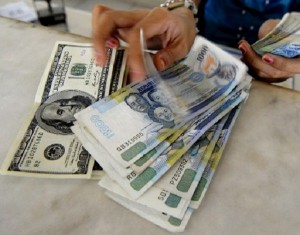MANILA — The peso on Monday further weakened against the US dollar, closing at 50.23:$1 to fall to over 10-year low again.
At the Philippine Dealing System, the peso hit an intraday low of 50.23:$1 and a high of 50.05:$1 after opening at 50.08:$1.
The peso’s close at the start of the week was the weakest since Sept. 26, 2006’s 50.32:$1.
The peso breached the 50:$1 level last Friday for the first time since Nov. 16, 2006’s close of 50.12:$1.
The total volume traded jumped to $723 million from $532 million at the end of last week.
Sought for comment on peso trading after it stayed at the 50:$1 level Monday morning, Bangko Sentral ng Pilipinas Governor Amando M. Tetangco Jr. noted in a text message to reporters that the domestic currency “tracked the softness in most regional currencies.”
The peso’s weakness was “also driven by risk-off sentiment amid geopolitical concerns, especially in Europe,” Tetangco added.
“The BSP does not target any exchange rate level, but we continue to watch out for excessive market volatility,” according to Tetangco.
The peso depreciated significantly today, as political uncertainties in Europe and optimism ahead of US President Donald J. Trump’s tax plan improved the dollar’s appeal as a safe-haven currency. Moreover, expectations of hawkish FOMC minutes later this week might have also weakened the peso,” Land Bank of the Philippines market economist Guian Angelo S. Dumalagan said, referring to the policy-setting Federal Open Market Committee (FOMC).
“Last Feb. 9, President Trump said that he might release the details of his fiscal reforms within the next two to three weeks. This implies that his fiscal plan might be released as early as this week,” Dumalagan noted.
Last December, economic managers raised its foreign exchange rate assumption for 2017 to a “comfortable” 48-50:$1 from 45-48:$1 previously even as the peso continued to weaken against the US dollar.
“We’re comfortable with 50:$1 as the upper bound for the exchange rate basically because we have steady inflow of dollars,” Budget Secretary Benjamin E. Diokno told reporters in December after a meeting of the Cabinet-level, interagency Development Budget Coordination Committee (DBCC). SFM
